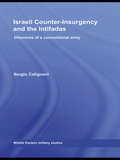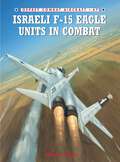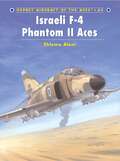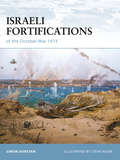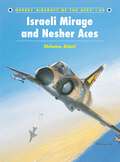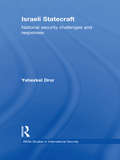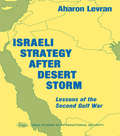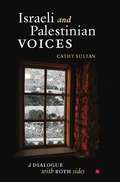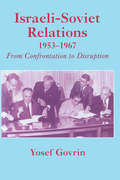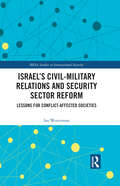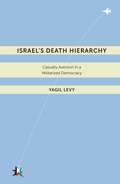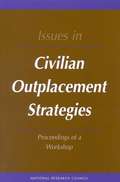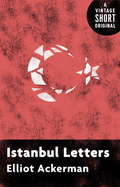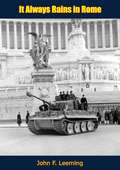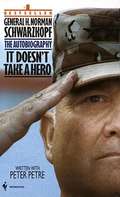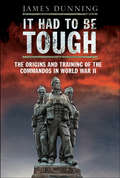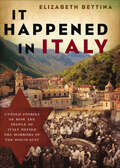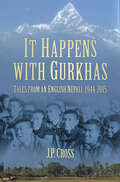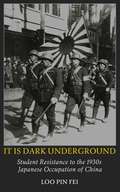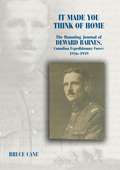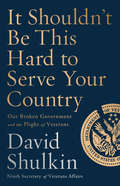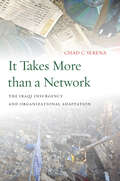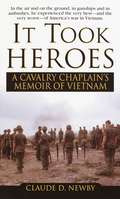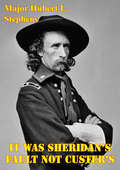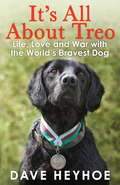- Table View
- List View
Israeli Counter-Insurgency and the Intifadas: Dilemmas of a Conventional Army (Middle Eastern Military Studies)
by Sergio CatignaniThis volume analyzes the conduct of the Israel Defence Forces (IDF) counter-insurgency operations during the two major Palestinian uprisings (1987-1993 and 2000-2005) in the Territories of the West Bank and Gaza Strip. It employs primary and secondary resources to produce a comprehensive analysis on whether or not the IDF has been able to adapt it
Israeli F-15 Eagle Units in Combat
by Shlomo Aloni Chris DaveyDiplomacy, politics and national trauma has dominated the frontline career of the Israeli F-15 to date. In the wake of the losses suffered in the October 1973 Yom Kippur War, the Israeli government opted for technology in an effort to reassure a traumatised population that they would never suffer a surprise attack from the air again. Despite Israel Defense Force Air Force (IDF/AF) interceptors having performed extremely successfully during the Yom Kippur War, they did not achieve the kind of results that allowed Israel to achieve future deterrence. The nation was not only looking for weapons that would win a war, but that would also prevent it in the first place. Post-Yom Kippur diplomacy enabled Israel to purchase the F-15 Eagle, which was then the world's best air-to-air fighter. For the first time in its history the IDF/AF could operate a fighter that was a full generation ahead of all opposing interceptors in the region. The first 'Kill' F-15 Baz (Buzzard) arrived in Israel in December 1976, and three years later it got the chance to prove its worth in combat. Israeli Baz pilots were credited with 12.5 kills between 1979 and 1981, with 33 victories following during the June 1982 Lebanon War. A further 4.5 kills followed in post-Lebanon War skirmishes. Despite all of this combat, no Israeli F-15 has ever been lost to enemy action. Once the jet secured air superiority and deterrence had been achieved along the Israeli borders, the IDF/AF went on to explore the Baz's long-range attributes and as air-to-ground capability. As an example of the former, Israeli F-15s escorted F-16 strike aircraft all the way to Iraq's nuclear reactor in June 1981, and in its bomber role, the type flew the IDF/AF's longest ever attack mission in October 1985 when it bombed the PLO headquarters in Tunis. Diplomacy prevailed again in the 1990s when the US government agreed to supply the IDF/AF with the F-15I Ra'am (Thunder) to fulfill the long-range surface-to-surface missile (SSM) mission post-Desert Storm. These aircraft also acted as a counter-balance to the sale of the F-15S to Saudi Arabia. A follow-on to the F-15I purchase was the development of the Improved Baz Avionics Upgrade Program, which saw the integration of many of the F-15I features into the older F-15A/B/C/D. From A to I, the extremely capable, and combat-tested, Israeli F-15 force will continue to deter potential enemies well into the foreseeable future.
Israeli F-4 Phantom II Aces
by Jim Laurier Shlomo AloniThe American manufactured F-4 Phantom II was used by the Israelis in air-to-ground missions, as an attack aircraft, and air-to-air missions as a fighter. Despite performing both roles with equal success the Israeli reliance on the Mirage III and Nesher delta fighters meant that the F-4 was used most regularly in its air-to-ground role. The kill total of the Israeli F-4 community was, consequently, a modest 116.5; significantly lower than that of other Israeli aircraft types in service between 1969 and 1982. A handful of aces were, nevertheless, created and, using first hand accounts, this unique book tells their stories. Many F-4 pilots had previously flown the Mirage III but most of the navigators were either inexperienced flying school graduates or had been transferred from transport aircraft. The decision to create such teams may have appeared an odd one and it certainly led to a number of interesting experiences but proved, ultimately, to be so successful that by 2010 the Israeli air force will have more two-seat combat aircraft than single-seat fighters. The F-4 experience was, therefore, crucial to moulding the future of the Israeli air force.
Israeli Fortifications of the October War 1973
by Steve Noon Simon DunstanThe Bar Lev Line along the Suez Canal was born out of the overwhelming victory of the Israel Defense Forces (IDF) in the Six Day War of 1967. Devastated by their defeat, the Egyptian army began a prolonged campaign of artillery bombardments of Israeli positions causing many casualties. Accordingly, the IDF Chief of Staff, General Haim Bar-Lev, ordered the construction of a series of fortified positions and observation posts that were named the Bar Lev Line by the Israeli press, thanks to its inevitable association with the heavily fortified Maginot Line.This book examines the original 23 positions of the Bar Lev Line, known as Moazims (Moaz is 'castle keep' in Hebrew), each of which were between five and 15 kilometers apart and surrounded by barbed wire and minefields. With rare photographs and cutaway artwork, the design of these positions is described. Finally, the author analyzes the effectiveness of these positions when the Egyptians launched an offensive on Yom Kippur 1973. Manned by just 436 reservists the Moazims were quickly cut off and the Israeli defenders paid a high price with a casualty rate of almost 50 percent. Although widely criticized, the Bar Lev Line proved a success during the war of attrition, and in 1973 it was the political and military failures which allowed the Moazims to be surrounded, rather than the failure of the defensive line itself.
Israeli Mirage III and Nesher Aces
by Shlomo Aloni Mark StylingIsraeli delta fighters pilots have been credited with almost 300 kills between 1966 and 1974, and dozens of them became aces. The Israeli aerial kill exchange rate and overall air-to-air performance was phenomenal. Although the Israeli pilots were flying Mach 2 fighters, they lacked any modern radar equipment and their MiG-21 flying opponents should have had a performance edge over them. This book details their most signifcant engagements, many of which were essentially World War 2 style dogfights fought with jet aircraft. Because neither side had the combat edge to disengage at will most engagements were a life and death struggle and the introduction of air-to-air missiles and the Israeli Nesher was to prove decisive in this theatre.
Israeli Statecraft: National Security Challenges and Responses
by Yehezkel DrorThis book offers a systematic examination, analysis and evaluation of Israeli national security statecraft in terms of challenges and responses. Providing an in-depth analysis of Israeli statecraft challenges and responses, this interdisciplinary book integrates social science and security studies with public policy approaches within a long-term historical perspective on the Arab-Israeli conflict. These scholarly approaches are synthesized with extensive personal knowledge of the author based on involvement in Israeli political-security policy making. This book makes use of conceptualizations of statecraft such as 'fuzzy gambling' and interventions with critical mass in ultra-dynamic historical processes to help clarify Israel's main statecraft successes and failures, alongside the wider theoretical apparatuses these concepts represent. While focused on Israel, these theoretical frameworks have important implications for the academic study of statecraft and statecraft praxis worldwide. This book will be of much interest to both statecraft practitioners and to students of Israeli politics and security, the Middle Eastern conflict, strategic studies and IR/security studies in general.
Israeli Strategy After Desert Storm: Lessons of the Second Gulf War (Besa Studies In International Security)
by Aharon LevranIraq's invasion of Kuwait and the Gulf War had a traumatic effect on the Middle East and its implications were particularly serious for Israel, which felt obliged to reassess its strategic and military perspectives. This is an examination of the lessons that the Gulf War holds for Israel.
Israeli and Palestinian Voices: A Dialogue with Both Sides
by Cathy SultanPart travelogue, part history, part sociological investigation, Israeli and Palestinian Voices begins with a fascinating account of Ms. Sultan's determined research trip to Jerusalem and Ramallah to interview many individuals on both sides of the conflict whose voices are seldom heard. <P><P>With her artificial metal knees and indomitable spirit, this American housewife braved checkpoints, barbed wire, and Merkur tanks to visit her informants.These illuminating, detailed interviews are followed by an historical primer for readers on the conflict's growth to its present standoff. Israeli and Palestinian Voices is a work for the interested layperson, a book to open eyes to the human realities of life in Israel-Palestine and to clearly show the thinking on all sides.
Israeli-Soviet Relations, 1953-1967: From Confrontation to Disruption (Cummings Center Series)
by Yosef GovrinAn |sraeli Ambassador's account of the longest and most tense period in Israeli-Soviet diplomatic relations, from their renewal in 1953 to their severance in 1967. His work analyses the era from the month preceding Stalin's death to the weeks following the Six Day War - one of severance, resumption and then severance again- along two parallel processes.
Israel’s Civil-Military Relations and Security Sector Reform: Lessons for Conflict-Affected Societies (Besa Studies In International Security Ser.)
by Ian WestermanThis book examines Israel’s civil-military relations (CMR) in order to explore alternatives to orthodox Western models of security sector reform (SSR) in post-conflict societies. This book argues that the guidelines of SSR have always tended to draw on theoretical work in the field of CMR and focus too heavily on Western, liberal democratic models of governance. Consequently, reform programs based on these guidelines, and intended for use in post-conflict and conflict-affected states, have had, at best, mixed results. The book challenges the necessity for this over-reliance on traditional Western liberal democratic solutions and instead advocates an alternative approach. It proposes that by drawing on an unconventional CMR model, that in turn references the specific context and cultural background of the particular state being subject to reform, there is a significantly higher chance of success. Drawing on a case study of Israel's CMR, the author seeks to provide practical assistance to those working in this area and considers the question of how this unorthodox CMR model might usefully inform post-conflict and conflict-affected SSR programmes. This book will be of interest to students of military studies, security studies, Israeli politics, and International Relations.
Israel’s Death Hierarchy: Casualty Aversion in a Militarized Democracy (Warfare and Culture #4)
by Yagil Levy2012 Winner of the Shapiro Award for the Best Book in Israel Studies, presented by the Association for Israel StudiesWhose life is worth more?That is the question that states inevitably face during wartime. Which troops are thrown to the first lines of battle and which ones remain relatively intact? How can various categories of civilian populations be protected? And when front and rear are porous, whose life should receive priority, those of soldiers or those of civilians? In Israel’s Death Hierarchy, Yagil Levy uses Israel as a compelling case study to explore the global dynamics and security implications of casualty sensitivity. Israel, Levy argues, originally chose to risk soldiers mobilized from privileged classes, more than civilians and other soldiers. However, with the mounting of casualty sensitivity, the state gradually restructured what Levy calls its “death hierarchy” to favor privileged soldiers over soldiers drawn from lower classes and civilians, and later to place enemy civilians at the bottom of the hierarchy by the use of heavy firepower. The state thus shifted risk from soldiers to civilians. As the Gaza offensive of 2009 demonstrates, this new death hierarchy has opened Israel to global criticism.
Issues in Civilian Outplacement Strategies: Proceedings of a Workshop
by Renae F. BroderickIn the past six years, planned downsizing has reduced the civilian work force of the U.S. Department of Defense from over 1 million to just under 850,000. By 2001, approximately 119,000 more civilian jobs will be eliminated. The reemployment picture for civilians is not strong, and the economic impact of base closings will also be felt by the surrounding communities.This book presents creative ideas for civilian outplacement based on or suggested by private-sector experiences. It discusses a number of issues that the Department of Defense must consider in its outplacement efforts, including organizational planning for effective outplacement services, whether or not to customize services for particular types of employees, monitoring outplacement practices to learn what works, and working with local communities in providing both job search and social services.
Istanbul Letters
by Elliot AckermanA Vintage Shorts Original Selection "Why do some forms of violence--the beheading of journalists by the Islamic State, a bombing in Ankara, or the attacks in San Bernardino and Orlando--make us feel so threatened, while other forms--the 372 separate mass shootings in America in 2015 or the 4,219 Syrians killed that same September--do little to challenge our sense of safety?" From his base in Istanbul, Elliot Ackerman has written letters and essays that explore how global and seemingly remote issues like terrorism, US foreign policy, and other geopolitical forces play out and wreak distress upon the quotidian lives of civilians. Here assembled into a haunting piece, the fragments of a year's notes open a window into life under President Recep Tayyip Erdoğan's oppressive and nationalistic right-wing regime, the civil war in Syria, and the disintegration of the old order in the Middle-East. Exposing how a pervasive rhetoric of fear can shape a society and written with intimacy and a tremendous amount of compassion, this is an astute political commentary and first-person travel narrative par excellence. An ebook short.
It Always Rains in Rome
by John F. LeemingThis story is set in a small Tuscan hilltown, and the action takes place towards the end of the Second World War. The violent action of war has left the town intact, but to cover their inevitable retreat, the Germans consider it necessary to blow up the fourteenth-century bridge for which the townspeople have a deep love, and on which their whole life depends. Its destruction would cause the river to flood and wash away the soil.In the desperate hope of preventing the calamity (and also to help save his own skin), the little Fascist mayor, despised by the people and the Germans alike, seeks a secret parley with the partisans, and asks them to persuade the British to frustrate the German plans. The communist partisan leader is deeply suspicious of this approach by the turncoat mayor, on whom he has long sworn revenge. But what really mortifies the mayor is that the British are planning to destroy the bridge themselves!—and the partisans are bound to support them.From this point the story becomes one hilarious fiasco of cross purposes, ludicrous incidents, and conflicting personalities, who all fail to achieve their ends owing to their national characteristics—the Germans owing to their attention to detail, the British to their casualness, and the Italians to....
It Doesn't Take a Hero
by Norman SchwarzkopfHe set his star by a simple motto: duty, honor, country. Only rarely does history grant a single individual the ability, personal charisma, moral force, and intelligence to command the respect, admiration, and affection of an entire nation. But such a man is General H. Norman Schwarzkopf, commander of the Allied Forces in the Gulf War. Now, in this refreshingly candid and typically outspoken autobiography, General Schwarzkopf reviews his remarkable life and career: the events, the adventures, and the emotions that molded the character and shaped the beliefs of this uniquely distinguished American leader.Note: The photo insert is not included in this edition.
It Had to be Tough: British Commandos In The Second World War
by James DunningThis book tells the fascinating story of the origins of the Commandos (Britain's first Special Service troops and the forerunners of today's Parachute Regiment, the SAS and the SBS) and the development of their special training in World War II. The commandos were raised on the specific and personal orders of the prime minister, Winston Churchill, in the dark days of the summer of 1940 when these islands faced the real threat of a Nazi invasion. It was a bold, but typically Churchillian, decision.The book traces the formation of the Commandos and the development of the extreme and often unorthodox training methods and techniques used to prepare the volunteers from all branches of the British Army for subsequent world-wide-operations from 'bolt and butcher' raids to the 'great raids' on Norway and France and finally their employment in the full scale invasions of North Africa. Sicily, Italy, Normandy, the Crossing of the Rhine and finally in Burma, whilst at all times fostering that indomitable fighting spirit with which the name 'Commando' became synonymous. So great was the Commandos' contribution in that war that the Army Commandos were awarded thirty eight Battle Honors and these are emblazoned on the Commando Flag which hangs in Westminster Abbey. Arguably the Army Commandos were disbanded too hastily after the War but their legacy, traditions and fighting spirit lives with those artillery, engineer and corps troops who today win their coveted 'Green Berets' and serve alongside their comrades of the Royal Marines on active service today.
It Happened in Italy: Untold Stories of How the People of Italy Defied the Horrors of the Holocaust
by Elizabeth BettinaIMAGINE ELIZABETH BETTINA&’S SURPRISE when she discovered that her grandmother&’s village had a secret: over a half century ago, many of Campagna&’s residents defied the Nazis and risked their lives to shelter and save hundreds of Jews during the Holocaust. What followed her discovery became an adventure as she uncovered fascinating untold stories of Jews in Italy during World War II and the many Italians who risked everything to save them. &“Finally, somebody made known the courage and the empathy of the majority of the Italian people toward us Jews at a time of great danger.&” —Nino Asocoli
It Happens with Gurkhas: Tales from an English Nepali, 1944-2015
by J P CrossGurkhas have served with the British for almost 200 years, first with the army of the East India Company, then with the Indian Army of the Raj, and then in 1947 becoming an integral part of the British Army. This anthology of articles from The Kukri, the Gurkha regimental journals, by J.P. Cross covers much of the past sixty years of their history, taking in the last days of the Second World War and the Indonesian Confrontation in the 1960s, and also gives an insight into the everyday life, culture and beliefs of these renowned soldiers.As a Gurkha officer, J.P. Cross had many unusual experiences in his long career: in 1945, for example, he was attached to a Japanese battalion in Indochina that was fighting for the British against the Viet Minh, and the only photograph taken of this Japanese unit finally laying down its weapons appears in this book. Later, he just managed to resolve a potentially deadly dispute between an offended Gurkha and a visiting South Vietnamese trainee at the Jungle Warfare School. He also describes several seemingly supernatural experiences whilst serving with troops from a culture where such things are firmly believed in.This is a unique anthology of articles drawn from an equally unique military career and a relationship with the Gurkhas that has lasted for over half a century.
It Is Dark Underground
by Pin-Fei LooIt is Dark Underground, first published in 1946, is the first hand account of student Loo Pin Fei in the Chibna of the 1930. The books details the efforts the students made to resist the Japanese occupation of their country, including non-violent means such as distributing leaflets as well as violent means such as bombings of theaters, setting fire to supply warehouses, and carrying out assassinations of pro-Japanese Chinese. The students also worked diligently to change public opinion toward the Japanese. Their efforts were set in a time of dramatic and sweeping change in China as the Nationalist and Communist movements grew and World War Two loomed on the horizon.
It Made You Think of Home: 1916-1919
by Bruce Cane"We took our positions, five kneeling and five standing … we got the order to fire. One blank and nine live rounds … I did not have the blank." That is the voice of Deward Barnes, an unwilling but dutiful member of the firing squad that shot Harold Lodge, one of 25 Canadians executed during the First World War. In this diary we hear something that is otherwise gone forever: the authentic voice of the First World War soldier, Everyman in khaki. Fully annontated so that everyone today can understand the nuance of each entry, the Barnes diary takes us into the trenches and the firing lines of the Western Front like no other first-hand Canadian account of that terrible war can. Like any trained infantryman, Deward could tell the kick of a live round from a blank one, and that kick he bestows on us with each turn of the page.
It Shouldn't Be This Hard to Serve Your Country: Our Broken Government and the Plight of Veterans
by David ShulkinThe former VA secretary describes his fight to save veteran health care from partisan politics and how his efforts were ultimately derailed by a small group of unelected officials appointed by the Trump White House.Known in health care circles for his ability to turn around ailing hospitals, Dr. David Shulkin was originally brought into government by President Obama to save the beleaguered Department of Veterans Affairs. When President Trump appointed him as secretary of the VA, Shulkin was as shocked as anyone.Yet this surprise was trivial compared to what Shulkin encountered as secretary: a team of political appointees devoted to stopping anyone -- including the secretary himself -- who stood in the way of privatizing the agency and implementing their political agenda. In this uninhibited memoir, Shulkin opens up about why the government has long struggled to provide good medical care to military veterans and the plan he had to solve these problems. This is a book about the commitment we make to the men and women who risk their lives fighting for our country, how the VA was finally beginning to live up to it, and why the new administration may now be taking us in the wrong direction.
It Takes More than a Network: The Iraqi Insurgency and Organizational Adaptation
by Chad C. SerenaIt Takes More than a Network presents a structured investigation of the Iraqi insurgency's capacity for and conduct of organizational adaptation. In particular, it answers the question of why the Iraqi insurgency was seemingly so successful between 2003 and late 2006 and yet nearly totally collapsed by 2008. The book's main argument is that the Iraqi insurgency failed to achieve longer-term organizational goals because many of its organizational strengths were also its organizational weaknesses: these characteristics abetted and then corrupted the Iraqi insurgency's ability to adapt. The book further compares the organizational adaptation of the Iraqi insurgency with the organizational adaptation of the Afghan insurgency. This is done to refine the findings of the Iraq case and to present a more robust analysis of the adaptive cycles of two large and diverse covert networked insurgencies. The book finds that the Afghan insurgency, although still ongoing, has adapted more successfully than the Iraqi insurgency because it has been better able to leverage the strengths and counter the weaknesses of its chosen organizational form.
It Took Heroes: A Cavalry Chaplain's Memoir of Vietnam
by Claude D. NewbyThe soldiers in 1st Cav fought some of Vietnam’s fiercest battles— and Chaplain Newby was there right beside them. For grunts in Vietnam, the war was a jungle hell of sudden death, endless suffering, and supreme courage. For Chaplain Newby, it was an honor to be chosen to share it with them. In enemy-held highlands and fetid jungles, Newby regularly accompanied patrols, company-sized missions, chopper strikes, and air rescues—sharing the men’s dreams, their fears, and their dying moments. Searing, brutally accurate, and dedicated to the truth, Claude Newby’s account of brave men fighting a tragic war captures that time in all its horror and heroism. Newby doesn’t shrink from exposing the war’s darker side; his quiet description of the murderous events that came to be known as “the Mao incident” proves that justice can prevail. Ultimately, Newby’s riveting stories reveal the tremendous valor and sacrifices of ordinary Americans facing constant danger, shattering losses, and an increasingly indifferent nation. His book is a shining tribute to those who fought, those who died, and those who came home to a country determined to forget them. From the Paperback edition.
It Was Sheridan's Fault Not Custer's: And The Ties To Current Planning
by Major Hubert L. StephensMartin van Creveld, a noted theorist, contends that the concept of operational art did not take off in the U.S. until after the Vietnam War. Conversely, James Schneider, a prominent military theorist, asserts that operational art began in the American Civil War. This monograph provides a holistic analysis of four Plains Indian War Campaigns. Lieutenant General (LTG) Philip Sheridan conducted all four campaigns. This analysis illustrates several enduring principles of both operational art and counterinsurgency (COIN) operations. The purpose of the monograph is to explain the initial failure of LTG Sheridan's 1876 Centennial Campaign against the Sioux and Cheyenne Indians. Additionally, this explanation relates the significance of LTG Sheridan's planning to contemporary COIN campaign planning. The overall methodology is the incorporation of four case studies to test the theory of sanctuary control and elimination of resources to defeat insurgencies.The monograph contains three key findings. The first key finding is that the failure at the Little Big Horn was LTG Sheridan's fault not LTC Custer's, and this directly relates to the second finding. The second key finding is the importance of operational art in designing a campaign plan to link tactical actions to strategic objectives. The third finding is the efficacy of some of the current COIN tenets...Ultimately, this monograph demonstrates the utility of a strategy of exhaustion and its resulting operations to control terrain and insurgent sanctuaries as well as to deny the enemy resources to defeat an insurgency.
It's All About Treo: Life and War with the World's Bravest Dog
by Damien Lewis Dave HeyhoeThis is the incredible true story of the unbreakable bond forged between Treo, the world's most highly decorated dog, and his handler Sgt. Dave HeyhoeWhen Dave Heyhoe was sent to Afghanistan to help detect the Taliban's murderous roadside bombs, he knew he'd need a special dog by his side. Luckily for him, his closest pal Treo, a staggeringly brave ball of energy and mischief was with him every step of the way. The two friends had a miraculous understanding that helped them save countless lives but, as they embarked on a roller-coaster emotional ride, Dave realized he needed Treo more than he could ever have imagined. Tear-jerkingly sad one moment, laugh-out-loud hilarious the next, It's All About Treo is a moving and uplifting story that will melt the hearts of animal lovers everywhere.
